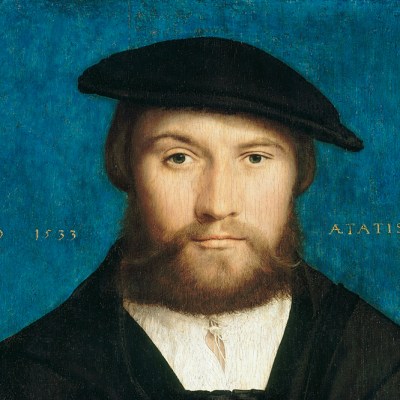The painting which opens ‘The Tudors: Passion, Power, and Politics’, an exhibition at the Holburne Museum in Bath, is an unexpected delight. It is a life cycle of Sir Henry Unton, commissioned by his widow, Dorothy, to commemorate his life and legacy. The painting, just over a metre and a half in length, follows him through his infancy, his education at Oxford, his travels through Venice, Padua, France and the Netherlands, and his life at home in Faringdon in Berkshire – where he works in his study, hosts banquets and masques, and plays music – all the way to his lamented death. At each stage, the sun’s rays shine on the hero, illuminating his progress. His extensive funeral procession weaves its way along the bottom of the painting; mourners in black solemnly follow his hearse. They are even depicted crossing the English Channel – presenting the Channel not as a border divide but as a means of conducting trade and sharing knowledge. The performative nature of the court is evident in the representation of the masque and the funeral procession; at the top is a memento mori, a skeleton behind Unton’s head. In this single painting is contained a summary of the entire Tudor era. It also includes the earliest visual depiction of an umbrella.
Sir Henry Unton (c. 1596), unknown artist. Photo: © National Portrait Gallery, London

This exhibition is a collaboration between the National Portrait Gallery, the Holburne Museum, and the Walker Art Gallery, where it will travel after its run in Bath (and will be expanded from just over 20 objects to more than 100). The closure of the National Portrait Gallery for renovations has provided an opportunity for it to lend huge portions of its collection, and the gallery’s support of regional museums during their closure has been significant. Two of the paintings in this exhibition – the Henry Upton piece, and a portrait of Jane Seymour begun shortly before her death – have never left London before.
The Tudor age is a much-loved period in British history – the huge number of TV documentaries and dramas, as well as fiction and non-fiction books attests to this – and its players are as familiar to us as any modern-day celebrity: Henry VIII standing tall in his power pose; Elizabeth I decked in pearls and extravagantly large sleeves. So the sensation of stepping into the exhibition is akin to meeting old friends, even if you have never seen these paintings in real life before. Thomas Cromwell, Thomas More, Thomas Cranmer, Mary Queen of Scots, Lady Jane Grey, Sir Francis Drake, Sir Walter Raleigh, William Cecil – everyone is there.
Henry VIII (c. 1537), Hans Holbein the Younger. Photo: © Victoria Art Gallery, Bath, and North East Somerset Council

Taking these works out of their usual home at the National Portrait Gallery and putting them in a stand-alone exhibition encourages visitors to really look, and get to know the personalities behind the images. Moving around the room gives one a rich sense of moving through the history of the dynasty – as well as through a century in the development of painting. Shifts in style – facial expressions, backgrounds, the use of depth and perspective, detailing of fabrics – are palpable.
The exhibition presents other, more personal stories. Francis Walsingham hangs beside his son in law, Philip Sidney. Robert Dudley is suspended between two queens, Elizabeth I and Mary Queen of Scots. Two miniatures by Gerlach Flicke – one a portrait, one a self-portrait – were painted when the artist and the sitter, Henry Strangwish, found themselves imprisoned together at the Tower of London. Elizabeth I locks eyes across the room with her father.
Queen Elizabeth I (c. 1588), unknown English artist. Photo: © National Portrait Gallery, London

As objects, these paintings have travelled those 500 years, and they tell their own stories. Some have faded – in a portrait of c. 1575, Elizabeth’s dress now looks white when it would have been deep crimson – while others have been altered, or cut down, as is the case with a portrait of Robert Dudley and the Armada portraits, most have been reframed. Faded paint in the portraits of Catherine of Aragon and Robert Dudley allow us glimpses of the preparatory sketches underneath on their faces. Jane Seymour is captured in an unfinished state, the sleeves, front of dress, and jewels around dress and headdress are left blank; we do not know why. The Lady Jane Grey has been attacked at some point in its life and her face bears the scars.
Lady Jane Grey (c. 1590–1600), unknown artist. Photo: © National Portrait Gallery, London

The themes are broad – it was a busy century – and the exhibition covers a lot of ground in a small space, dividing the paintings into themes: Dynasty, Religion, Conflict, Empire, Queenship. Its success lies in never seeming confused or hurried; the focus is on making the history relatable. The interpretation of history is always shaped by what survives and by who tells the story. Portraits are more likely to survive than narrative or decorative paintings, so what has been handed down to us over time are these images, and the larger-than-life characters they represent. In this exhibition, they are allowed to tell their own stories.
‘The Tudors: Passion, Power, and Politics’ is at the Holburne Museum, Bath, until 8 May.



